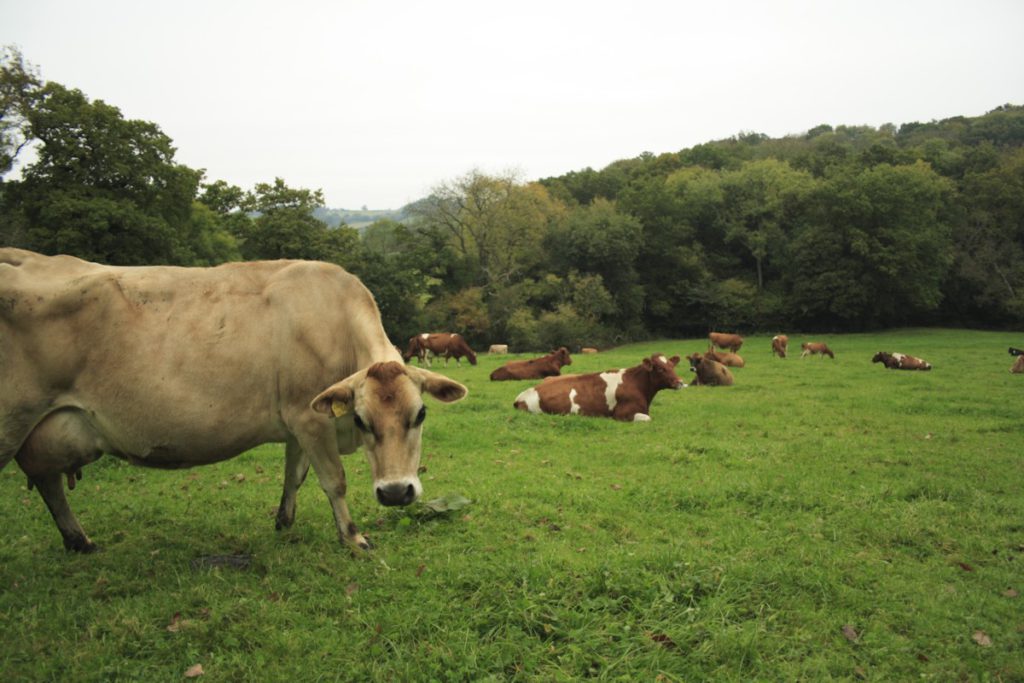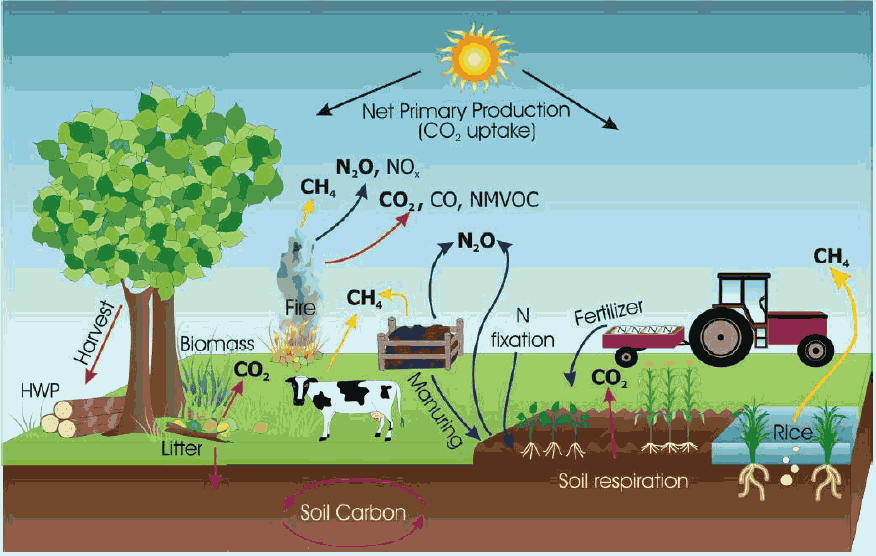Greenhouse gases (GHGs) are the source of climate change. These gases, the most important of which are carbon dioxide and methane, form a ‘blanket’ around the planet when they are released into the atmosphere (known as the ‘greenhouse effect’), trapping heat and warming the Earth.
Introduction
Greenhouse gases (GHGs) are responsible for the greenhouse effect, which warms the Earth’s surface leading to climate change. Research shows that emissions equivalent to those from over 50 average households are produced from a 100 hectare cereal farm every year. The emissions are even higher for dairy farms.
Although these gases are released naturally, it is the additional output from human sources (for example: power generation, transport and agriculture) that tips the natural balance over the edge and creates a warming effect. This effect is not new to science and was discovered as long ago as the nineteenth century. Taking action to reduce emissions of GHGs is essential to prevent climate change – much can be done by farmers to help reduce them.
Agriculture is responsible for 10% of all greenhouse gas emissions in the UK. Together with related emissions from changing land use and cutting down forests, it accounts for 24% of GHG emissions globally.
Agricultural Greenhouse Gases
Agriculture produces three main types of gases which are dangerous to the climate: nitrous oxide (agriculture is the largest global source of this gas), methane, and carbon dioxide. Carbon dioxide (CO2) is the most common GHG globally, and therefore provides the ‘benchmark’ for measuring other GHGs’ damage (CO2e, or carbon dioxide equivalent).

In terms of agriculture, methane and nitrous oxide are produced in greater quantities than carbon dioxide and have a higher carbon dioxide equivalent, therefore they are the most significant gases associated with farming.
Nitrous oxide (N2O) is 265 times more harmful than carbon dioxide, so reducing output of this gas is particularly important.
Methane (CH4) is another very powerful greenhouse gas, and is 27 times more damaging than carbon dioxide (source), although it spends less time in the atmosphere, estimated to be on average 12 years after which most of it is broken down.
CO2 is less damaging than N2O and CH4 but remains in the atmosphere for around 100 years. For this reason, any emissions today will continue to affect future generations; this is why we are already ‘locked in’ to a certain amount of global temperature rise.
Consequently there has been a discussion raised as to the methodology of accounting for the true contribution of methane and thus the proposal of the GWP* approach. This approach (global warming potential star) allows comparison of the global warming impacts of different gases. It is a measure of how much energy the emissions of 1 ton of a gas will absorb over a given time, relative to the emissions of CO2. The star accounts for differences in short (e.g. methane) and long (e.g. carbon dioxide and nitrous oxide) lived climate pollutants.
Sources of agricultural greenhouse gases
The majority of agricultural GHG emissions come from the following sources:
- Livestock rearing and natural processes
- Crop fertilisation using chemical fertilisers
- Materials used to build and maintain farms
- Energy use of the farm buildings and vehicles
- Transport and distribution during and after growing
- Soil based emissions from disturbing soils
- Waste produced as a result of farming processes
Nitrous oxide (N2O)
Nitrous oxide comes largely from manure and fertiliser use. For example, highly managed grassland produces large volumes of emissions due to fertiliser use and soil disturbance.
Nitrous oxide is produced naturally in soils through microbial processes, but the increase in fertiliser use for intensive arable crops dramatically increases emissions.
The amount of N2O emitted when applying fertiliser or manure to crops will vary depending on weather conditions, quantity applied, soil moisture, soil structure and method of application.
Methane (CH4)
Methane is produced by livestock, via ‘ruminant enteric fermentation’; the gas is released as a result of bacteria in the stomachs of cows and sheep and the natural processes that release these.
Methane emissions from livestock vary - beef cattle account for around three quarters of such emissions, while dairy cattle account for around one-fifth, primarily due to different feeding regimes. Numbers of livestock a farm has and the feed they eat will determine the levels of emissions.
Methane is also produced from manure, but emissions differ depending on management techniques – for example, handling lagoon or tank based manure creates the largest methane emissions as the substance decays without oxygen. Daily spreading of manure generates the lowest, as oxygen is added during the process.
Carbon Dioxide (CO2)
A host of everyday and farming related activities emit carbon dioxide, such as driving around the farm, product distribution, and energy use. The main sources are burning diesel and petrol when transporting products or travelling to and from your farm, and the conventional energy (oil, gas, coal) used to power lights, and for cooling and heating.
Land use change is one of the largest sources of CO2 emissions worldwide. For example draining peat soils, converting woodland to intensively farmed fields and removing natural habitats. Disturbing soil also releases CO2 via regular tilling and soil compaction from heavy machinery. Adopting ‘minimum tillage’ and ‘no-tillage’ techniques prevent soil disturbance and drastically reduce such emissions while improving soil quality and structure. This will be covered in more detail in the ‘Your Farm’ section of the toolkit.
Farming's Potential to Absorb Greenhouse Gases
Farming has a unique part to play in absorbing (or ‘sequestering’) carbon emissions, and is unique as an industry in being able to offer these opportunities.
For example, carbon dioxide can be removed from the atmosphere by soils, by plant and crop growing cycles and by woodland. This can help ‘balance’ the cycle of GHGs in the atmosphere and help prevent climate change.

Therefore, it's extremely important that farmers do what they can to help lower Britain's carbon footprint.
Ways for farms to absorb greenhouse gases are covered in more detail in later sections of the Toolkit.
Further information:
Analysis of UK farming and food chain GHG emissions -http://assets.wwf.org.uk/downloads/how_low_report_1.pdf
GHG emissions by food group -http://www.fcrn.org.uk/sites/default/files/Food_production_and_GHGs.pdf
Detailed exploration of accounting for farm-based GHG emissions -http://adlib.everysite.co.uk/resources/000/241/422/FS25.pdf
GHG emissions from UK dairy farms -http://www.fcrn.org.uk/sites/default/files/greenhouse_gas_report.pdf
Focus on Nitrous Oxide – Nitrous Oxide Group - http://www.nitrousoxide.org/

